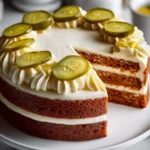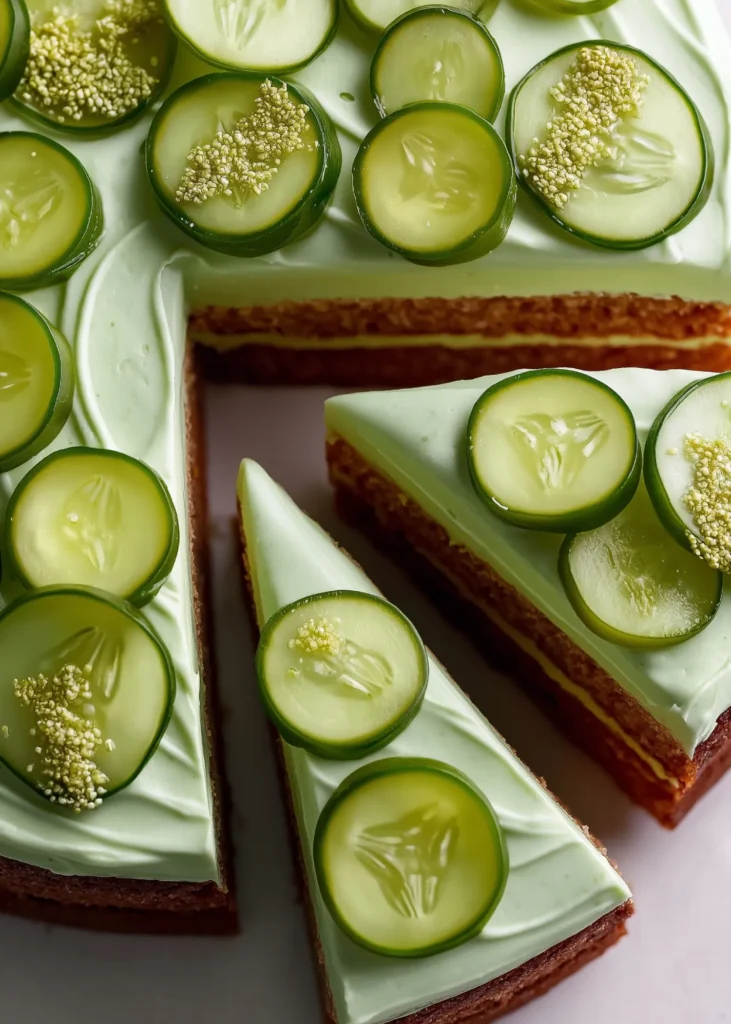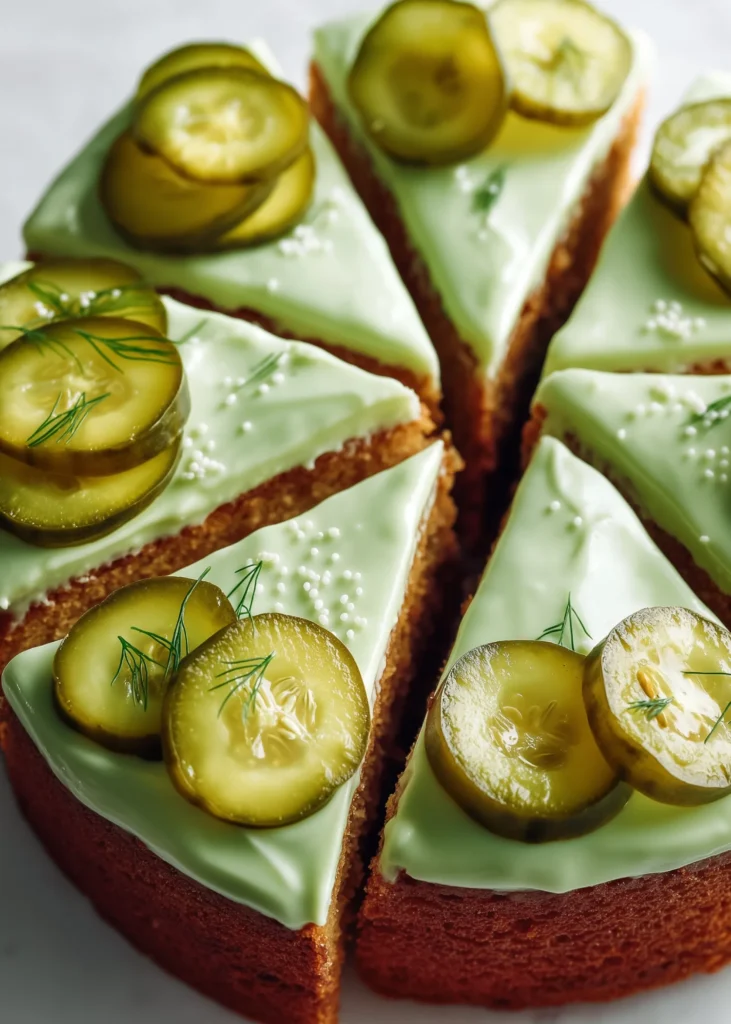Pickle cake recipe—yes, you read that right. It’s one of those surprising creations that spark curiosity and end with a sweet, tangy bite you’ll want to share again and again. At Wish-Cake.com, this quirky, flavorful dessert fits perfectly into our mission: bringing warmth, creativity, and just a touch of nostalgia to every kitchen.
My love for baking started in my grandmother’s kitchen, where cinnamon-scented memories and flour-dusted laughter were part of every recipe. Years later, that passion grew into a way of life—from dorm-room cupcakes to late-night brownies shared with friends. Now, as a mom of two, baking is how I connect with my kids and keep those cherished traditions alive.
Through Wish-Cake.com, I share recipes that turn everyday ingredients into something magical. This pickle cake recipe is no exception. It’s sweet, moist, and just quirky enough to make baking fun again.
Contents
- 1 Ingredients Breakdown and Customization Tips
- 2 Pickle Cake Recipe
- 3 Step-by-Step Instructions to Make Pickle Cake
- 4 Unique Taste and Texture Explained
- 5 Frosting & Topping Ideas to Complement Pickle Cake
- 6 Exploring Similar Recipes with a Twist
- 7 Storage, Serving, and Make-Ahead Tips
- 8 Jazz Up Your Cake Mix: Tips & Tricks
- 9 Fun Facts and Origins Behind Pickle Cake Recipe
- 10 Conclusion: Try the Pickle Cake Recipe and Start a New Tradition
- 11 FAQs About the Pickle Cake Recipe
Ingredients Breakdown and Customization Tips
Essential Ingredients for a Classic pickle cake recipe
The magic of this pickle cake recipe lies in the way simple pantry staples combine with one unexpected twist—pickle juice. Here’s a closer look at what you’ll need and why each ingredient matters:
| Ingredient | Purpose |
|---|---|
| All-purpose flour (1½ cups) | Acts as the foundation that holds the entire cake together |
| Sugar (1 cup) | Introduces a gentle hint of sugar to smooth out the sharp bite of the brine |
| Baking soda (1 tsp) | Helps the cake rise and stay fluffy |
| Salt (½ tsp) | Enhances the flavors and complements the pickles |
| Pickle juice (1 cup) | Infuses tangy flavor and moisture—core to the recipe |
| Vegetable oil (½ cup) | Keeps the cake moist and soft |
| Eggs (2 large) | Brings everything in the mix together and lets the cake hold steady as it bakes |
| Finely chopped pickles (1 cup) | Adds texture and bursts of flavor throughout each bite |
| Vanilla extract (1 tsp) | Balances the flavor with a hint of sweetness |
The real surprise is how the pickle juice doesn’t overpower but instead brightens the pickle cake recipe, giving it a slight zing and ultra-moist texture. And those chopped pickles? They bring tiny pops of tangy sweetness hidden throughout each bite.
Optional Add-Ins and Flavor Tweaks for Personalization
Thinking about giving this pickle cake a personal twist? Try these fun twists:
- Use sweet pickles if you prefer a softer, more dessert-like flavor.
- Add crushed nuts, like walnuts or pecans, for crunch.
- Incorporate spices such as cinnamon or nutmeg for a warmer flavor profile.
- Mix in shredded carrots for a carrot-cake fusion.
- Swap vanilla for almond extract for a nuttier finish.

Pickle Cake Recipe
- Total Time: 45 minutes
- Yield: 1 round 8-inch cake (8 servings) 1x
Description
This pickle cake recipe is the ultimate surprise dessert — sweet, tangy, moist, and unlike anything you’ve tried before. Made with real dill or sweet pickle juice and finely chopped pickles, it delivers bold flavor with every bite. Perfect for adventurous bakers or anyone craving something new, this cake pairs beautifully with creamy frosting or a playful pickle garnish. Whether served at parties or baked just for fun, it’s a savory-sweet treat that always starts conversations. Easy to make and full of flavor, it’s the dessert you didn’t know you needed.
Ingredients
- 1 ½ cups all-purpose flour
- 1 cup sugar
- 1 teaspoon baking soda
- ½ teaspoon salt
- 1 cup pickle juice (from a jar of dill or sweet pickles)
- ½ cup vegetable oil
- 2 large eggs
- 1 cup finely chopped pickles (dill or sweet, your choice)
- 1 teaspoon vanilla extract
Instructions
- Preheat your oven to 350°F (175°C). Grease and flour an 8-inch round cake pan.
- In a mixing bowl, bring together the dry items—use your flour, a touch of sugar, some baking soda, and a pinch of salt.
- In a separate container, blend the liquid ingredients—pickle juice, oil, and eggs—until the texture becomes smooth and unified.
- Carefully pour the liquid mix into the dry blend and stir gently. Stop once the two mixtures are just combined—avoid over-stirring.
- Fold in chopped pickles and vanilla extract. Mix gently until evenly distributed.
- Transfer the final batter into your baking dish, spread the surface evenly, and let it bake in the oven for around 30 to 35 minutes.
- Cool for 10 minutes in the pan, then transfer to a rack. Decorate with pickle slices before serving.
Notes
- Use dill pickles for a bold flavor or sweet pickles for a milder taste.
- Dice pickles finely to ensure even texture in the cake.
- Add a tangy pickle juice frosting for a savory-sweet finish.
- Can be made ahead and stored up to 2 days at room temperature or 5 days refrigerated.
- Prep Time: 15 minutes
- Cook Time: 30–35 minutes
- Category: Cakes Recipes
- Method: Baking
- Cuisine: American
Nutrition
- Serving Size: 8 slices
- Calories: 250 kcal
- Sugar: 20g
- Sodium: 320mg
- Fat: 11g
- Saturated Fat: 1.2 g
- Unsaturated Fat: 9.8 g
- Trans Fat: 0 g
- Carbohydrates: 34 g
- Fiber: 1 g
- Protein: 3g
- Cholesterol: 35 mg
Step-by-Step Instructions to Make Pickle Cake
Preparing the Batter: Mixing Wet and Dry Components

Making this pickle cake recipe is simple, satisfying, and perfect for both seasoned bakers and beginners. It’s all about mixing pantry staples with a splash of creativity—and, of course, that star ingredient: pickle juice.
Step-by-step instructions:
- Set your oven to 350°F and allow it to fully heat up, ensuring it’s at the right temperature before you begin baking. While it warms up, grease a round cake pan with butter and lightly dust it with flour. This ensures your pickle cake recipe releases smoothly once it’s baked.
- Mix Dry Ingredients: In a large mixing bowl, combine 1½ cups all-purpose flour, 1 cup sugar, 1 tsp baking soda, and ½ tsp salt. This base creates the soft, tender texture of the cake.
- In a separate bowl, blend together one cup of briny pickle juice, half a cup of oil, and two eggs until well combined. This blend creates the foundation of the cake, ensuring a tender texture with a refreshing tang.
- Slowly combine the liquid mix with the dry, stirring gradually until it turns into a lump-free batter. Stir gently, just until everything is blended. Mix just until combined to maintain an airy structure—too much stirring can make the cake heavy.

Baking Tips and Oven Temperature Guidelines
Now it’s time to bring this quirky, flavorful cake to life.
- Carefully mix in a cup of finely diced pickles and a teaspoon of vanilla to infuse it with unexpected flavor. The added ingredients bring a fun crunch and bold taste that give this pickle cake its one-of-a-kind charm.
- Bake It Perfectly: Pour the batter into your prepared pan, smoothing the top evenly. Place the baking dish into the oven and allow it to bake for 25 to 35 minutes. Test for doneness by poking the center with a toothpick; if it comes out dry and crumb-free, it’s done. The smell? Surprisingly irresistible.
- After baking, keep the cake in its pan for about 10 minutes to settle, then move it onto a wire rack to cool down entirely. For an extra pickle punch, garnish with thinly sliced pickles on top—it’s a bold touch that matches the flavor.
Expert Tips:
- Make sure your oven hits the right temperature before you start baking to get consistent results every time.
- Use fresh dill or sweet pickles depending on the flavor profile you prefer.
- Try mini versions of this pickle cake recipe as cupcakes—they’re great for parties.
With this method, you’ll master the pickle cake recipe that’s as curious as it is crowd-pleasing. It’s proof that sometimes the best desserts come from taking risks—and a little jar of pickles.
Unique Taste and Texture Explained
What Do Pickle Cakes and Cupcakes Taste Like?
This cake brings a sugary taste paired with a sharp, surprising edge. The pickle taste doesn’t dominate—it’s mild but brings a crisp, zesty twist that catches you off guard in the best way. Think carrot cake or lemon loaf, but with a salty-sweet balance that keeps you curious.
If you make pickle cupcakes, expect the same soft, moist crumb with a slightly crunchy bite from the finely chopped pickles. Use sweet pickles for a more dessert-like taste or go bold with dill for a savory touch.
How Pickle Juice Adds Moisture
The star of this pickle cake recipe is the pickle juice—it’s what gives the cake its soft, springy texture. The acidity helps the baking soda do its job, making the cake rise nicely while keeping it moist.
Plus, the juice enhances flavor. It makes the sweetness pop and gives the cake depth, just like adding lemon or vinegar to a dish.
Frosting & Topping Ideas to Complement Pickle Cake
Dill Pickle Buttercream vs. Sweet Cream Toppings
Once your pickle cake recipe is baked and cooled, the question becomes: how do you frost it? You can take it in either direction—keep it dessert-like or give it a bold, savory spin. Both work surprisingly well.
If you’re adventurous, try a dill pickle buttercream. Yes, it’s a thing—and it’s oddly satisfying. Whip together soft butter, powdered sugar, a splash of pickle juice, and a pinch of salt for a balanced frosting.
Prefer something more traditional? A smooth blend of vanilla and cream cheese creates a frosting that’s gently sweet with a soft, tangy kick. This mixture gives the cake a whimsical twist, somewhat reminiscent of a tangy carrot cake. You can also try whipped cream or even a thin lemon glaze for something light and fresh.
Not sure which to pick? Do a taste test with both options in cupcake form. Or for extra sweetness, drizzle a bit of honey or maple syrup over the top.
Garnishing Ideas: Pickle Slices, Herbs, and More
When it comes to toppings, don’t be afraid to get playful. The visual appeal of your pickle cake recipe adds to the surprise.
Here are a few ideas:
- Thin pickle slices arranged on top for a bold look (best with sweet pickles).
- Fresh dill or mint leaves for a touch of green and an herbal note.
- Candied pickles (yes, it’s real!) for a sweet-savory crunch.
- Stir in crushed pretzels for an extra salty crunch that livens up the texture.
Exploring Similar Recipes with a Twist
Pickle Cupcakes and Their Popularity
If you’re already intrigued by the pickle cake recipe, imagine the same bold flavor packed into a small, bite-sized form: pickle cupcakes. These mini cakes use the same moist, tangy base but are baked in muffin tins for about 18–20 minutes, making them perfect for parties and taste-testing fun.
What makes pickle cupcakes stand out is their incredible versatility in flavors and textures. Consider decorating one portion with a creamy dill-infused frosting, while adorning the remaining half with a traditional vanilla or zesty lemon glaz. The mix of sweet and savory highlights the unique charm of this adaptable pickle-inspired dessert.
Their quirky vibe and eye-catching look have helped them trend across social platforms like TikTok and Pinterest. Whether for a culinary event or a kitchen experiment, these treats are sure to spark curiosity—and might just convert non-pickle fans.
Other Unusual Cakes You Should Try
Tried the pickle cake recipe and feeling adventurous? You’re in for more surprises. These creative desserts flip the script on traditional baking—turning everyday ingredients into bold, unforgettable treats.
Try these:
- A soft spiced cake made with carrots and a touch of pineapple, bringing a gentle island-like twist to every bite
- A bold chocolate dessert blended with beetroot for deep flavor, natural sweetness, and a striking color punch.
- A quirky vintage dessert made with canned soup, born from tough times but rich in flavor
- This soft cake cleverly includes zucchini, offering moisture without any noticeable veggie taste.
Like the pickle cake, these recipes challenge your assumptions about dessert—and almost always turn skeptics into fans.
In the end, the charm of the pickle cake recipe isn’t just in the flavor—it’s in its ability to surprise, start conversations, and turn something as simple as a jar of pickles into a dessert you’ll remember. Whether baking a whole cake or individual cupcakes, this quirky recipe deserves a spot in your regular lineup.
Storage, Serving, and Make-Ahead Tips
How to Store Pickle Cake for Freshness
Once your pickle cake recipe is baked and cooled, proper storage is key to keeping it moist and flavorful. Thanks to the pickle juice and oil base, this cake naturally retains moisture longer than traditional sponge cakes—but it still needs care.
For best results:
- Keep your pickle cake recipe fresh on the counter by sealing it in a tight container. It’ll be fine to eat for the next couple of days.
- Refrigeration: For longer storage (up to 5 days), wrap the cake in plastic wrap or place in a sealed container before refrigerating.
- Want to save some for later? You can chill the whole cake or just wrap up a few pieces and freeze them. Seal it snugly in foil, place it in a freezer bag, and keep frozen for as long as eight weeks. Thaw at room temperature before serving.
Avoid storing it uncovered, as the edges may dry out. If using a frosting like dill buttercream, refrigeration is best, but always allow the cake to come to room temp before serving to soften the texture and enhance the flavor.
Serving Suggestions for Events or Parties
The beauty of the pickle cake recipe is that it’s as fun to serve as it is to bake. Whether you’re hosting a brunch, game night, or birthday party, here are a few ideas to serve it in style:
- Sliced with flair: Top each slice with a small sprig of dill and a paper-thin pickle slice for presentation.
- Cupcake style: Make individual portions and offer frosting choices—sweet or savory.
- Mini layer cake: Split the cake horizontally and spread frosting between layers, then top with crushed pretzels for crunch.
Pair it with lemonade, a light iced tea, or even something bubbly like prosecco—especially if you’re going the savory route. The unexpected flavor of this cake makes it a great conversation starter, so keep it front and center on the dessert table.
Planning ahead? You can mix your batter ahead of time—just stash it in the fridge and it’ll stay good for a full day. Just stir gently before pouring into the pan. Planning ahead lets you whip up homemade treats even when your schedule’s packed.
Jazz Up Your Cake Mix: Tips & Tricks
How to Jazz Up a Boxed Cake Mix with Pickle Juice
Short on time but still want to try a bold, unique dessert? You can turn a simple boxed mix into a quirky treat using the same approach as our pickle cake recipe. Yes, even store-bought mixes can handle a splash of creativity!
Here’s how to do it:
- Use a boxed vanilla or butter-flavored cake blend as the starting point for your recipe
- Replace the water called for in the instructions with pickle juice—it delivers the same moisture with an unexpected tang.
- Fold in roughly three-quarters of a cup of diced pickles to add a punch of flavor and a bit of crunch to the mix.
- Stick with eggs and oil, or swap part of the oil with sour cream to make it richer.
This shortcut version keeps the spirit of the pickle cake recipe alive but gets you from mixing bowl to oven in just a few minutes. It’s perfect for casual events or last-minute baking sessions where you still want something fun and unforgettable.
Creative Mix-ins to Elevate Your Store-Bought Cake
Beyond the basics, you can take your pickle cake recipe—or even a boxed mix—to the next level with a few simple mix-ins:
- Incorporate a small amount of garlic powder into the batter to introduce a savory depth, complementing the tanginess of dill pickles..
- Fold in finely chopped pecans or walnuts to add a delightful crunch and nutty flavor to the mixture
- Mix in grated carrots if you’re aiming for a blend of pickle flavor and carrot cake vibes.
- Top with crushed pretzels or kettle chips before baking for a sweet-and-salty finish.
Pro Tip: If using a boxed mix, reduce the sugar slightly if you’re adding sweet pickles or sugary toppings. This keeps the balance just right.
Whether you go full homemade or remix a box mix, the core of any great pickle cake recipe is the same: bold flavor, moist texture, and a spirit of fun.
Fun Facts and Origins Behind Pickle Cake Recipe
The Surprising Origins of Unusual Desserts
Believe it or not, the concept behind the pickle cake recipe isn’t as new as it sounds. Throughout culinary history, people have experimented with unusual ingredients in baking—especially during times of scarcity.
Back in the Great Depression, when money and supplies were tight, people got creative in the kitchen. Instead of using fresh dairy or eggs, they relied on pantry staples like vinegar, canned tomato soup, or even a scoop of mayonnaise to bake cakes that still turned out moist and flavorful.
That tradition of resourceful, inventive baking laid the groundwork for recipes like this one. Pickles, with their intense flavor and long shelf life, naturally found their way into the mix. And what started as a quirky substitution turned into a memorable flavor experiment that actually works.
Similar unexpected desserts—like chocolate cakes with beets or chili powder, and cookies made with potato chips—follow the same principle: bold, contrasting flavors that surprise and delight.
Why the Pickle Cake Recipe Works Today
The rise of the pickle cake recipe today aligns with growing food trends like “curiosity baking” and “TikTok recipes.” Social media has brought out a new wave of adventurous cooks who love pushing the boundaries of what dessert can be. And when people discover that pickle juice can add tang, texture, and moisture to a cake? They’re all in.
Whether you’re baking it for laughs, for curiosity, or just because you love a flavor challenge, this cake has real staying power. The sweet-savory balance, the moist crumb, and the bold topping options give it a place alongside classics—because it delivers more than just taste. It delivers a reaction.
Conclusion: Try the Pickle Cake Recipe and Start a New Tradition
Now that you’ve seen how flavorful, creative, and surprisingly easy the pickle cake recipe is, it’s time to try it yourself. Whether you’re baking to impress, explore something new, or just have fun with ingredients in your pantry, this recipe is guaranteed to be a memorable hit.
It’s not just about being quirky. It’s about using food to spark joy, start conversations, and create memories in your kitchen—just like we do every day here at Wish-Cake.com.
For More Delicious And Easy Recipes Follow Me In Facebook And Pinterest.
FAQs About the Pickle Cake Recipe
What do pickle cupcakes taste like?
Pickle cupcakes taste sweet, moist, and tangy with a subtle vinegar brightness. They’re not overpoweringly salty or sour—instead, the pickle juice balances out the sugar and brings moisture and a soft crumb. If you’ve tried lemon or spice cupcakes, you’ll recognize the same sweet-and-sharp flavor play. Dill adds a bold punch, while sweet pickles mellow it out.
What is olive oil cake?
Olive oil cake is a Mediterranean-inspired dessert made using olive oil instead of butter or vegetable oil. It results in a soft, moist cake with a rich flavor and slightly fruity undertones. Like the pickle cake recipe, it uses unexpected pantry staples to achieve a balance of moisture, flavor, and simplicity—just with a different twist.
How to jazz up a packet cake mix?
Jazzing up a box mix is easy—swap out water for pickle juice to recreate the core flavor of a pickle cake recipe. Add mix-ins like chopped pickles, shredded carrots, or crushed pretzels. You can also try replacing the oil with sour cream or yogurt for a creamier texture. Toppings like tangy frosting or sweet glazes push your boxed cake from basic to brilliant.
What is in the cake?
A classic pickle cake recipe includes all-purpose flour, sugar, baking soda, salt, pickle juice, vegetable oil, eggs, chopped pickles, and vanilla extract. Each ingredient plays a role—pickle juice adds moisture and zing, while eggs and oil keep the crumb tender. The result is a cake that’s as surprising as it is satisfying.

